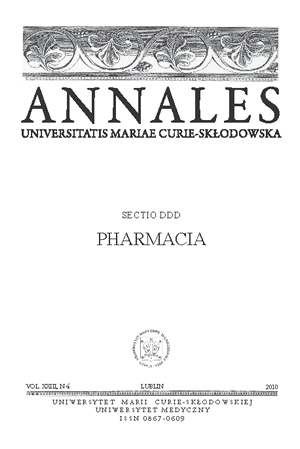Osteocalcine concentration in saliva and blood serum conducted on postmenopausal patients
Keywords:
osteocalcine, BMD, osteoporosis, menopauseAbstract
The aim of this study was to show the difference between the concentration of osteocalcine in serum and saliva of menopausal patients and to demonstrate the correlation between the concentration of this biomarker and bone density. The examination included 60 postmenopausal women, 30 of whom underwent oophorectomy. Half of the women were treated with hormone replacement therapy (HRT). Samples of blood and saliva were tested using ELISA. Densitometry was conducted on the lumbar vertebral column. Densitometry revealed a significant difference in BMD between patients not undergoing HRT and those receiving HRT. Concentration of osteocalcine in serum ranged from 3.59ng/ml to 580ng/ml. A statistically significant fluctuation of osteocalcine in serum was discovered in the post-oophorectomy group. Examination of saliva showed differences in marker concentration, which in a statistically significant way involved menopausal women and patients treated with HRT. There is a negative correlation between BMD and osteocalcine levels in the blood serum of menopausal women and women undergoing HRT. Osteocalcine concentration in saliva is slightly lower than in serum. Measurements presented in this study were subject to variations that make it difficult to derive a definitive thesis. It is recommended that future studies on larger cohorts are undertaken to vacilitate more reliable results.
References
1. Bauer D., Sklarin P., Stone K. et al.: Biochemical markers of bone turnover and prediction of hip bone loss in older women: the study of osteoporotic fractures. J. Bone Miner. Res., 14, 1404, 1999.
2. Becker A., Handick K., Roberts W., Garetto L.: Osteoporosis risk factors in female dental patients. A preliminary report. J. Indiana Dent. Assoc., 76, 15, 1997.
3. Bullon P., Goberna B., Guerrero J. et al.: Serum, saliva, and gingival crevicular fluid osteocalcin: their relation to periodontal status and bone mineral density in postmenopausal women. J. Periodontol., 76:513, 2005.
4. Bullon P., Chandler L., Segura Egea J. et al.: Osteocalcin in serum, saliva and gingival crevicular fluid: their relation with periodontal treatment outcome in postmenopausal women. Med. Oral Patol. Oral Cir. Bucal., 12, E193, 2007.
5. Davidson B. et al.: Total and free estrogens and androgens in postmenopausal women with hip fractures. J. Clin. Endocrinol. Metab., 54, 115, 1982.
6. Delmas P., Stenner D., Wahner H. et al.: Increase in serum bone gamma carboxyglutamic acid protein with ageing in women. J. Clin. Invest., 71, 1316, 1983.
7. Frumar A et al.: Relationship of fasting urinary calcium to circulating estrogen and body weight in postmenopusal women. J. Clin. Endocrinol. Metab., 50, 70, 1980.
8. Garnero P., Grimaux M., Demiaux B. et al.: Measurement of serum osteocalcin with a human- specific two-site immunoradiometric assay. J. Bone Miner. Res. 12, 1389, 1992.
9. Gurban C., Tanasie G., Gotia S. et al.: Osteocalcin and estradiol markers of bone calls in postmenopausal osteoporosis. Physiology, 17, 4, 2007.
10. Hassager C., Christiansen C.: Influence of soft-tissue body composition on bone mass and metabolism. Bone, 10, 415, 1989.
11. Hinoi E., Gao N., Jung D. et al.: The sympathetic tone mediates leptin's inhibition of insulin secretion by modulating osteocalcin bioactivity. J. Cell Biol., 183, 1235, 2008.
12. Holvik K., Meyer H.E., Søgaard A.J. et al.: Biochemical markers of bone turnover and their relation to forearm bone mineral density in persons of Pakistani and Norwegian background living in Oslo, Norway: The Oslo Health Study. Eur. J. Endocrinol., 155, 5, 693.
13. Jędrzejuk D., Milewicz A.: Otyłość, a osteoporoza. Katedra i Klinika Endokrynologii i Diabetologii AM we Wrocławiu Osteoforum, Terapia 2001, magazyn internetowy.
14. Kim Y., Paik I., Rhie Y., Suh S.: Integrative Physiology: Defined Novel Metabolic Roles of Osteocalcin. J. Korean Med. Sci., 25, 985, 2010.
15. Klein J. et al.: Clearence of BGP in adults with end-stage renal disease undergoing CAPD in Advances in Peritoneal Dialysis, eds. Khanna R., Nolph K.D. et al., 7, 225, 1991.
16. Lee E., Kang B., Seo J. et al.: Biochemical Bone Markers in Postmenopausal Women. Korean J. Obstet. Gynecol., 40, 1450, 1997.
17. Lee N., Sowa H., Hinoi E. et al.: Endocrine regulation of energy metabolism by the skeleton. Cell, 130, 456, 2007.
18. Lewandowski B., Kita K., Kita J. et al.: Ocena przydatności biochemicznych markerów przebudowy kości oraz perspektywy diagnostyczne w procesie rozpoznawania osteoporozy. Nowa Medycyna, Osteoporoza 3/2004
19. McGehee J., Johnson R.: Biomarkers of Bone Turnover Can Be Assayed From Human Saliva. The Journals of Gerontology: Series A : Biological sciences and medical sciences. Oxford, 59A, 3, 196, 2004.
20. Mechanovic-Nikolic J., Lalos-Miljus J.: Tartare-resistant acid phosphatate and osteocalcin in patients with osteoporosis and osteopenia. Jugoslov. Med. Biohem., 25, 411, 2006.
21. Minisola S., Rosso R., Romagnoli E. et al.: Serum osteocalcin and bone mineral density at various skeletal sites: A study performed with three different assays, Osteoporosis Int., 6, 1, 0937, 1996.
22. Paganini-Hill A. et al.: Menopusal estrogen therapy and hip fractures. Ann. Intern. Med., 95, 28, 1981.
23. Shiraki M., Itabashi A.: Short-term menatetrenone therapy increases gamma-carboxylation of osteocalcin with a moderate increase of bone turnover in postmenopausal osteoporosis: a randomized prospective study, The Japanese Society for Bone and Mineral Research and Springer 2009.
24. Steiniche T., Hasling C., Charles P. et al.: The effect of etidronate on trabecular bone remodeling in postmenopausal spinal osteoporosis – a randomized study comparing intermittment treatment and a ADFR regime. Bone, 12, 155, 1991.
25. Topic E., Primorac D., Jankovic S.: Medyczno-biochemiczna diagnostyka w praktyce klinicznej. Medicinska Naklada, Zagrzeb (Chorwacja), 2004.
Downloads
Published
Issue
Section
License
Copyright (c) 2010 Authors

This work is licensed under a Creative Commons Attribution-NonCommercial-NoDerivatives 3.0 Unported License.


